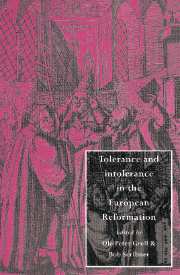Book contents
- Frontmatter
- Contents
- List of contributors
- Preface
- Dedication
- 1 Introduction
- 2 The travail of tolerance: containing chaos in early modern Europe
- 3 Preconditions of tolerance and intolerance in sixteenth-century Germany
- 4 Heresy executions in Reformation Europe, 1520–1565
- 5 Un roi, une loi, deux fois: parameters for the history of Catholic-Reformed co-existence in France, 1555–1685
- 6 Confession, conscience and honour: the limits of magisterial tolerance in sixteenth-century Strassburg
- 7 One Reformation or many? Protestant identities in the later Reformation in Germany
- 8 Toleration in the early Swiss Reformation: the art and politics of Niklaus Manuel of Berne
- 9 Tolerance and intolerance in sixteenth-century Basle
- 10 Exile and tolerance
- 11 The politics of toleration in the Free Netherlands, 1572–1620
- 12 Archbishop Cranmer: concord and tolerance in a changing Church
- 13 Toleration for Catholics in the Puritan revolution
- 14 The question of tolerance in Bohemia and Moravia in the age of the Reformation
- 15 Tolerance and intolerance in sixteenth-century Hungary
- 16 Protestant confessionalisation in the towns of Royal Prussia and the practice of religious toleration in Poland-Lithuania
- Index
16 - Protestant confessionalisation in the towns of Royal Prussia and the practice of religious toleration in Poland-Lithuania
Published online by Cambridge University Press: 07 December 2009
- Frontmatter
- Contents
- List of contributors
- Preface
- Dedication
- 1 Introduction
- 2 The travail of tolerance: containing chaos in early modern Europe
- 3 Preconditions of tolerance and intolerance in sixteenth-century Germany
- 4 Heresy executions in Reformation Europe, 1520–1565
- 5 Un roi, une loi, deux fois: parameters for the history of Catholic-Reformed co-existence in France, 1555–1685
- 6 Confession, conscience and honour: the limits of magisterial tolerance in sixteenth-century Strassburg
- 7 One Reformation or many? Protestant identities in the later Reformation in Germany
- 8 Toleration in the early Swiss Reformation: the art and politics of Niklaus Manuel of Berne
- 9 Tolerance and intolerance in sixteenth-century Basle
- 10 Exile and tolerance
- 11 The politics of toleration in the Free Netherlands, 1572–1620
- 12 Archbishop Cranmer: concord and tolerance in a changing Church
- 13 Toleration for Catholics in the Puritan revolution
- 14 The question of tolerance in Bohemia and Moravia in the age of the Reformation
- 15 Tolerance and intolerance in sixteenth-century Hungary
- 16 Protestant confessionalisation in the towns of Royal Prussia and the practice of religious toleration in Poland-Lithuania
- Index
Summary
Within the history of toleration the case of Poland presents a somewhat reverse chronology compared with developments in the rest of early modern Europe. The famous Polish culture of tolerance was essentially a phenomenon of the late Middle Ages and the sixteenth century. It had developed in the context of the construction of a multinational monarchy under the Jagiellonian kings, and it offered a legal and ideological framework that was able fairly easily to accommodate the Reformation once it gained massive support among the Polish and Lithuanian nobility from the 1550s onwards. The subsequent period instead saw tolerance in decline. From roughly the mid seventeenth century onwards religious tension both between Christians and non-Christians and among the Christian confessions seemed to grow steadily, finally culminating in a series of violent conflicts over the so-called ‘dissident’ question that immediately preceded the partition of 1772. In short: the Poles seem to have ‘invented’ tolerance well before it became an issue of humanistic and proto-enlightened debate; but they apparently abandoned it precisely at the time when elsewhere religious tolerance became part of a commonly shared European culture.
This chapter offers some tentative explanations of this phenomenon, focusing mainly on what seems to have been the turning point in this long-term development: the period of confessionalisation. In this context three points will be argued.
1. The history of the legal and constitutional framework for religious toleration in Poland-Lithuania has to be clearly distinguished from the parallel developments on the levels of religious culture and popular religiosity, since the turn towards intolerance in Poland-Lithuania from the mid-seventeenth century onwards seems to have been essentially a phenomenon of the latter levels.
- Type
- Chapter
- Information
- Tolerance and Intolerance in the European Reformation , pp. 262 - 281Publisher: Cambridge University PressPrint publication year: 1996
- 6
- Cited by



